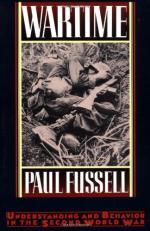
|
| Name: _________________________ | Period: ___________________ |
This test consists of 15 multiple choice questions and 5 short answer questions.
Multiple Choice Questions
1. Ernie Pyle was notable for taking great pains in his writing to list what?
(a) Medals and citations.
(b) Names of enlisted men.
(c) Place names.
(d) An individual's characteristics.
2. German soldiers were typically stereotyped as being which of the following?
(a) Incredibly strong.
(b) Bloodthirsty berserkers.
(c) Extremely stealthy.
(d) Unthinkingly loyal.
3. Allegedly, agents working for the axis spread what rumor?
(a) The Oder river had never been crossed by an invading force.
(b) French women all bore venereal diseases.
(c) German soldiers ate metal shavings with their food.
(d) Soldiers' wives were unfaithful.
4. According to the author, most of the well-known novels about WWII are really about what?
(a) Boredom.
(b) Discipline.
(c) Petty hazing.
(d) Officers.
5. Hazing occurred at what levels within the American military?
(a) At all levels.
(b) At the low-levels only.
(c) At the middle and upper levels.
(d) At the middle levels only.
6. The author compares military training to which of the following?
(a) Public school.
(b) A crucible.
(c) Police force training.
(d) The classic Greek gymnasium.
7. At the beginning of World War II, aerial combat was regarded as exemplifying what obsolescent ideal?
(a) Honor.
(b) Single combat.
(c) Dueling.
(d) Chivalry.
8. Compared with the enlisted men, officers would best be described as which of the following?
(a) Cowardly.
(b) Intelligent.
(c) Entitled.
(d) Aggressive.
9. How did the military handle blunders that resulted in casualties?
(a) By paying double insurance to grieving families.
(b) By attributing them to enemy action.
(c) By ignoring them.
(d) By covering them up.
10. What belief about the Japanese caused Americans to think that their war with Japan would end quickly?
(a) They had no heavy weapons or large ships.
(b) They were inefficient soldiers.
(c) They lacked discipline.
(d) They were a backwards people.
11. Talismans were believed to perform what function?
(a) Protect the soldier in combat.
(b) Bring the soldier luck.
(c) Allow the soldier to recover from wounds.
(d) Give the soldier physical strength.
12. According to one rumor, female axis agents were sent to the allies with what?
(a) Venereal diseases.
(b) Poison lipstick.
(c) Bombs.
(d) Concealable radios.
13. What types of bombers were believed to be key to the war-effort?
(a) Jet-propelled bombers.
(b) Heavy bombers.
(c) Medium bombers.
(d) Fighter-bombers.
14. The drinking among servicemen when alcohol was freely available would best be described as which of the following?
(a) Jovial.
(b) Excessive.
(c) Reasonable.
(d) Social.
15. According to the author, the hazing of enlisted men by officers would best be described as which of the following?
(a) Uncommon.
(b) Official policy.
(c) Rare.
(d) Pervasive.
Short Answer Questions
1. Which of the following is NOT one of the reasons that armies historically favored younger soldiers?
2. What is one reason given for why rumors were started?
3. Soldiers in their thirties were often called what?
4. Americans believed that heavy bombers had what quality?
5. How did the American media react to the image of many conscripts being drunkards?
|
This section contains 479 words (approx. 2 pages at 300 words per page) |

|




